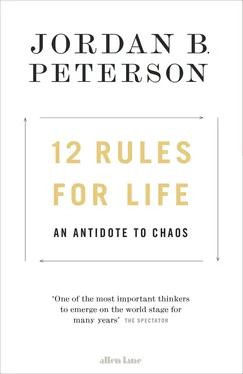This time, the now enraged lobsters come at each other viciously, with their claws extended, to grapple. Each tries to flip the other on its back. A successfully flipped lobster will conclude that its opponent is capable of inflicting serious damage. It generally gives up and leaves (although it harbours intense resentment and gossips endlessly about the victor behind its back). If neither can overturn the other—or if one will not quit despite being flipped—the lobsters move to Level 4. Doing so involves extreme risk, and is not something to be engaged in without forethought: one or both lobsters will emerge damaged from the ensuing fray, perhaps fatally.
The animals advance on each other, with increasing speed. Their claws are open, so they can grab a leg, or antenna, or an eye-stalk, or anything else exposed and vulnerable. Once a body part has been successfully grabbed, the grabber will tail-flick backwards, sharply, with claw clamped firmly shut, and try to tear it off. Disputes that have escalated to this point typically create a clear winner and loser. The loser is unlikely to survive, particularly if he or she remains in the territory occupied by the winner, now a mortal enemy.
In the aftermath of a losing battle, regardless of how aggressively a lobster has behaved, it becomes unwilling to fight further, even against another, previously defeated opponent. A vanquished competitor loses confidence, sometimes for days. Sometimes the defeat can have even more severe consequences. If a dominant lobster is badly defeated, its brain basically dissolves. Then it grows a new, subordinate’s brain—one more appropriate to its new, lowly position. [18008] Yeh S-R, Fricke RA, Edwards DH (1996) “The effect of social experience on serotonergic modulation of the escape circuit of crayfish.” Science, 271 , 366–369.
Its original brain just isn’t sophisticated to manage the transformation from king to bottom dog without virtually complete dissolution and regrowth. Anyone who has experienced a painful transformation after a serious defeat in romance or career may feel some sense of kinship with the once successful crustacean.
The Neurochemistry of Defeat and Victory
A lobster loser’s brain chemistry differs importantly from that of a lobster winner. This is reflected in their relative postures. Whether a lobster is confident or cringing depends on the ratio of two chemicals that modulate communication between lobster neurons: serotonin and octopamine. Winning increases the ratio of the former to the latter.
A lobster with high levels of serotonin and low levels of octopamine is a cocky, strutting sort of shellfish, much less likely to back down when challenged. This is because serotonin helps regulate postural flexion. A flexed lobster extends its appendages so that it can look tall and dangerous, like Clint Eastwood in a spaghetti Western. When a lobster that has just lost a battle is exposed to serotonin, it will stretch itself out, advance even on former victors, and fight longer and harder. [18009] Huber, R., Smith, K., Delago, A., Isaksson, K., & Kravitz, E. A. (1997). “Serotonin and aggressive motivation in crustaceans: Altering the decision to retreat.” Proceedings of the National Academy of Sciences of the United States of America, 94 , 5939–42.
The drugs prescribed to depressed human beings, which are selective serotonin reuptake inhibitors, have much the same chemical and behavioural effect. In one of the more staggering demonstrations of the evolutionary continuity of life on Earth, Prozac even cheers up lobsters. [18010] Antonsen, B. L., & Paul, D. H. (1997). “Serotonin and octopamine elicit stereotypical agonistic behaviors in the squat lobster Munida quadrispina ( Anomura, Galatheidae ).” Journal of Comparative Physiology A: Sensory, Neural, and Behavioral Physiology, 181 , 501–510.
High serotonin/low octopamine characterizes the victor. The opposite neurochemical configuration, a high ratio of octopamine to serotonin, produces a defeated-looking, scrunched-up, inhibited, drooping, skulking sort of lobster, very likely to hang around street corners, and to vanish at the first hint of trouble. Serotonin and octopamine also regulate the tail-flick reflex, which serves to propel a lobster rapidly backwards when it needs to escape. Less provocation is necessary to trigger that reflex in a defeated lobster. You can see an echo of that in the heightened startle reflex characteristic of the soldier or battered child with post-traumatic stress disorder.
The Principle of Unequal Distribution
When a defeated lobster regains its courage and dares to fight again it is more likely to lose again than you would predict, statistically, from a tally of its previous fights. Its victorious opponent, on the other hand, is more likely to win. It’s winner-take-all in the lobster world, just as it is in human societies, where the top 1 percent have as much loot as the bottom 50 percent [18011] Credit Suisse (2015, Oct). Global Wealth Report 2015 , p. 11. Retrieved from https://publications.credit-suisse.com/tasks/render/file/?fileID=F2425415-DCA7-80B8-EAD989AF9341D47E
—and where the richest eighty-five people have as much as the bottom three and a half billion.
That same brutal principle of unequal distribution applies outside the financial domain—indeed, anywhere that creative production is required. The majority of scientific papers are published by a very small group of scientists. A tiny proportion of musicians produces almost all the recorded commercial music. Just a handful of authors sell all the books. A million and a half separately titled books (!) sell each year in the US. However, only five hundred of these sell more than a hundred thousand copies. [18012] Fenner, T., Levene, M., & Loizou, G. (2010). “Predicting the long tail of book sales: Unearthing the power-law exponent.” Physica A: Statistical Mechanics and Its Applications, 389 , 2416–2421.
Similarly, just four classical composers (Bach, Beethoven, Mozart, and Tchaikovsky) wrote almost all the music played by modern orchestras. Bach, for his part, composed so prolifically that it would take decades of work merely to hand-copy his scores, yet only a small fraction of this prodigious output is commonly performed. The same thing applies to the output of the other three members of this group of hyper-dominant composers: only a small fraction of their work is still widely played. Thus, a small fraction of the music composed by a small fraction of all the classical composers who have ever composed makes up almost all the classical music that the world knows and loves.
This principle is sometimes known as Price’s law, after Derek J. de Solla Price, [18013] de Solla Price, D. J. (1963). Little science, big science . New York: Columbia University Press.
the researcher who discovered its application in science in 1963. It can be modelled using an approximately L-shaped graph, with number of people on the vertical axis, and productivity or resources on the horizontal. The basic principle had been discovered much earlier. Vilfredo Pareto (1848–1923), an Italian polymath, noticed its applicability to wealth distribution in the early twentieth century, and it appears true for every society ever studied, regardless of governmental form. It also applies to the population of cities (a very small number have almost all the people), the mass of heavenly bodies (a very small number hoard all the matter), and the frequency of words in a language (90 percent of communication occurs using just 500 words), among many other things. Sometimes it is known as the Matthew Principle (Matthew 25:29), derived from what might be the harshest statement ever attributed to Christ: “to those who have everything, more will be given; from those who have nothing, everything will be taken.”
Читать дальше












